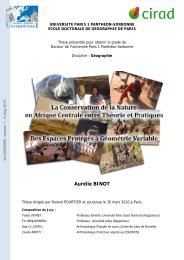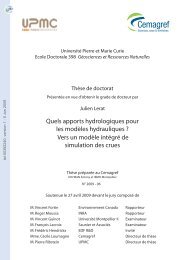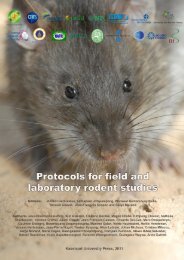Impact des métaux lourds sur les interactions plante/ver de terre ...
Impact des métaux lourds sur les interactions plante/ver de terre ...
Impact des métaux lourds sur les interactions plante/ver de terre ...
You also want an ePaper? Increase the reach of your titles
YUMPU automatically turns print PDFs into web optimized ePapers that Google loves.
Partie C : Résultats – Chapitre C-Icaliginosa) can <strong>sur</strong>vive in soils polluted with heavy metals and can even accumulate heavymetals such as Cd, Pb, Cu and Zn (14-16). Earthworms can also increase metal availability insoil by burrowing and casting and can, therefore, modify the efficiency of phytoremediation(17). The presence of earthworms can also increase Zn availability (18), although the authorssuggested that the main reason for the increase in Zn uptake by the plants was probably theincrease in the production of dry matter stimulated by earthworms.tel-00486649, <strong>ver</strong>sion 1 - 26 May 2010Lantana camara L., which is an hyperaccumulating plant owing to its remarkablecapacity to extract lead and cadmium from polluted soils in Vietnam (19), has been suggestedas a mo<strong>de</strong>l species for research on phytoextraction of metals. Howe<strong>ver</strong>, the speciesPontoscolex corethrurus (Oligochaeta, Glossoscolecidae), which is an endogenous tropicalearthworm, is <strong>ver</strong>y common in wetlands in Vietnam in both polluted and unpolluted areas.The burrowing and casting activities of this species have consi<strong>de</strong>rable impact on soil structure(20). Moreo<strong>ver</strong>, this species plays an important role on the rates of mineral N availability forplants, the assimilation of phosphorous and in the recycling of other nutrients and could,therefore, be involved in phyoextraction of metals (21,22).This study sets out to <strong>de</strong>termine the impact of the Pontoscolex corethrurus earthwormon Lantana camara growth and the phytoextraction process in soil artificially contaminatedwith lead at different levels.2. Materials and methods2.1. Soil collection and characterizationUnpolluted soil was collected from the A1 horizon in the grounds of the Phu AnEcomuseum, Binh Duong Province, Vietnam. It was an acid (pH=5), sandy (19.9% sand,72.2% silt, and 7.9% clay) soil with an intermediate fertility of 34.2% OM, 4.9% total N,7.9% P and tested negative for heavy metal pollution. The soil was sieved to < 5 mm, airdriedand mixed to obtain homogenous soil samp<strong>les</strong>. Experimental pots (microcosms) werefilled with 10 kg of dry soil. The soil was artificially contaminated with lead(CH 3 COO) 2 .3H 2 O at 500 mg.kg -1 and 1000 mg.kg -1 dry weight (DW). The soil’s fieldcapacity was <strong>de</strong>termined using five additional microcosms by weighing the pots after drainingthe soil for 24 hours.58
















